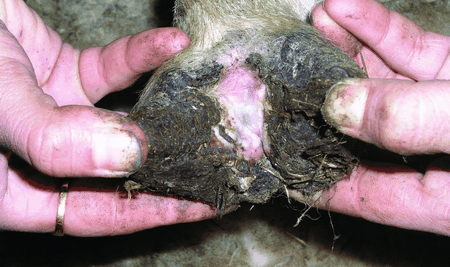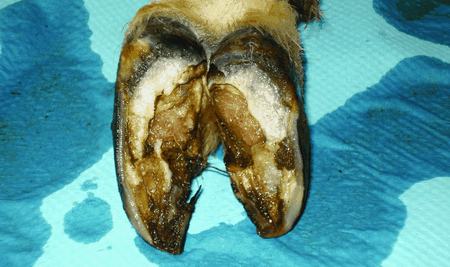Identify cause of lameness and improve your returns
Ongoing warm, moist weather conditions will provide the ideal environment for increased cases of scald and footrot in sheep flocks this autumn.
The GB sheep industry loses £24m a year to footrot alone – equal to £1.50 a sheep. Losses from all causes of lameness are far higher. It remains one of the top sheep health issues and a practical challenge for many producers.
Levels of lameness vary in flocks according to season and management, but the average flock is estimated to be carrying about 10% lame sheep. Farmers who have made a particular effort to manage lameness achieve levels as low as 3%.
“We may not be able to eradicate lameness entirely, but we can certainly make a positive impact on the financial penalty producers currently incur,” says sheep farmer and EBLEX board member David Raine.
“Lameness cannot be cured by one magic bullet – it needs strategic management which identifies the cause, sets a target level that is acceptable, takes steps to prevent further infection and treats any afflicted individuals immediately.”
The commonest form of lameness is scald, also known as strip or interdigital dermatitis. It shows up as a red/pink inflammation between the claws and is caused by a bacterium, Fusobacterium necrophorum, which is present in soil and faeces. Infection occurs through damaged skin, or prolonged exposure to moisture which softens the skin.

The tell-tale signs of a scald lesion between the claws.
Scald can often be a pre-cursor for footrot, as it allows the entry of another bacterium – Dichelobacter nodosus, which lives on sheep’s feet. Infection is most likely to spread in warm moist weather.

Footrot infection produces a grey, oozing pus. The hoof horn separates from the foot – working from the centre outwards.
“Identifying the type of lesion you are dealing with is the first important step to managing it,” says Liz Ford, EBLEX regional project manager. “The new BRP manual Target Lameness for Better Returns outlines the six main causes of lameness affecting sheep in this country.
“It has photographs showing examples of all six lesions, as well as labelled drawings of sheep feet. It then suggests the most appropriate treatment and prevention strategies for each.”
- EBLEX manual Number 7, Target Lameness for Better Returns, is available free to English levypayers who have signed up for the Sheep Better Returns Programme. Call 0870 241 8829 or email brp@eblex.org.uk for a copy.
| Case study Tracey Goodwin – HEREFORDSHIRE Paddock grazing, regular foot-bathing and foot trimming only when necessary helped Herefordshire sheep farmer Tracey Goodwin reduce lameness in his 1000-ewe flock from 20% down to just two to three percent%. “We thought we could reduce the number of lameness cases, but weren’t sure how to tackle it,” says Mr Goodwin. “So we read a lot and listened to people we respected – then adapted what we learned to our farm.” Mr Goodwin believes dividing large fields into paddocks and rotating groups of 130 to 150 ewes every week to ten days, had the biggest impact. This minimised the build-up of footrot bacteria in the pasture. A purpose-built handling system located in the centre of the paddock system meant that ewes could easily be brought in for regular footbaths – once a week during the first year, and then go out into clean, dry fields. Other management techniques included putting lame sheep in an isolation paddock near the footbath, culling all ewes that came lame three times within a few weeks and only trimming feet that had grown long. “Our aim was to get on top of the lameness problems over three years – but in fact the difference was really noticeable after the first year,” adds Mr Goodwin. |
